Gerlinde Fenkart-Froeschl’s CAA Portugal Reunion Diary
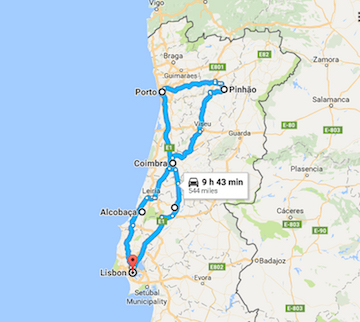 October 14-21, 2016
October 14-21, 2016
(Photos by Jean Marc Bara;
map from Ed and Mary Tan)
Here is an account of the CAA trip to Portugal, organized by Wolfgang Fenkart-Froeschl.
For more photos, please click here.
Thursday, 13.10.
As an entree to our Chase Alumni Portugal trip, we had a very enjoyable dinner with the early arrivals, at the Restaurant “Solar do Presunto”. Walking through downtown Lisbon afterwards was fun, and nobody got lost.
Friday, 14.10.
With most of the tour participants having arrived, our guide, Michelle de Gouveia, came to our hotel, Pousada de Lisboa, at 3 pm. We met at the bar for early drinks or coffee and “great to see you again…long time, no see…have you any news of so-and-so…” The noise level was quite high!
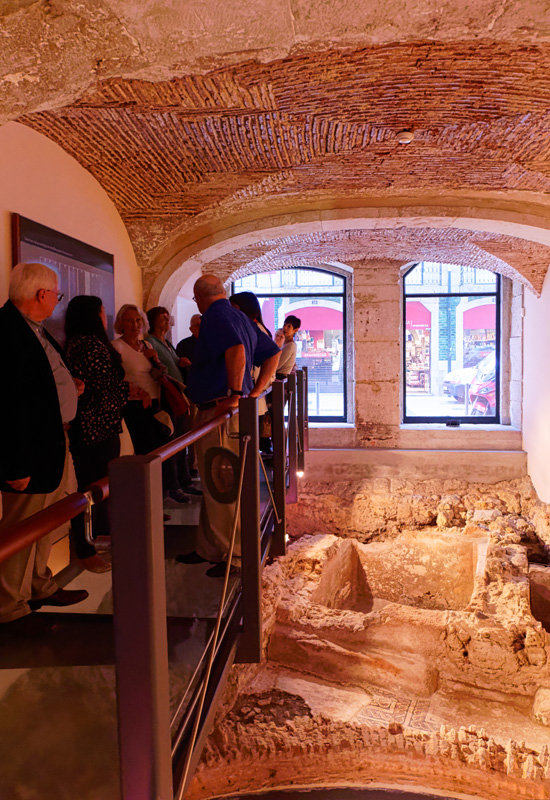 After this get-together, we took a short walk through the “Baixa” (the district is the heart of Lisbon that was completely rebuilt after the devastating 1755 earthquake), ending with a very interesting visit to the Millenium bcp Bank. When the bank began restoration of its basement in 1991 to put in vaults, it found Phoenician and Roman ruins–including a fish factory!). They decided to put the vaults elsewhere and leave the excavations as a museum open to the public. Interestingly enough, amphores produced in the neighborhood of Lisbon were recovered in different cities of the Roman Empire. (People must have loved the fish paste that was produced in Lisbon!) It was amazing to see how much deeper the ground level was compared to that of nowadays Lisbon.
After this get-together, we took a short walk through the “Baixa” (the district is the heart of Lisbon that was completely rebuilt after the devastating 1755 earthquake), ending with a very interesting visit to the Millenium bcp Bank. When the bank began restoration of its basement in 1991 to put in vaults, it found Phoenician and Roman ruins–including a fish factory!). They decided to put the vaults elsewhere and leave the excavations as a museum open to the public. Interestingly enough, amphores produced in the neighborhood of Lisbon were recovered in different cities of the Roman Empire. (People must have loved the fish paste that was produced in Lisbon!) It was amazing to see how much deeper the ground level was compared to that of nowadays Lisbon.
After this visit, at the bank’s downtown headquarters, Miguel Braganza, vice chairman of Millenium bcp, gave us an overview of the challenging economic situation in Portugal.
For our Welcome Dinner, we all (including the latecomers) met at the pretty Pousada ballroom for cocktails and a lovely meal (with substantial wine consumption), in our best attire. We were happy that Mariana Abrantes de Sousa could join us for this event. Unfortunately, John Ward could not be with us, as he was in a New York hospital, and his wife, Denise, had to return home the next day. We missed them! (John is fine now.)
Saturday, 15.10.
After breakfast in a very pretty atrium, we waited for our tuk-tuks (a type of auto rickshaw), but everything was delayed due to rain,. To pass the time, Michelle explained “Fado” to us (full of saudade = longing, sadness); she even played some on her smart phone. She did NOT sing (and maybe that was good?).
The tuk-tuk ride was abbreviated. But in spite of the pouring rain, we had a beautiful view over Lisbon from the Miradouro da Graca–if the many umbrellas did not block your view.
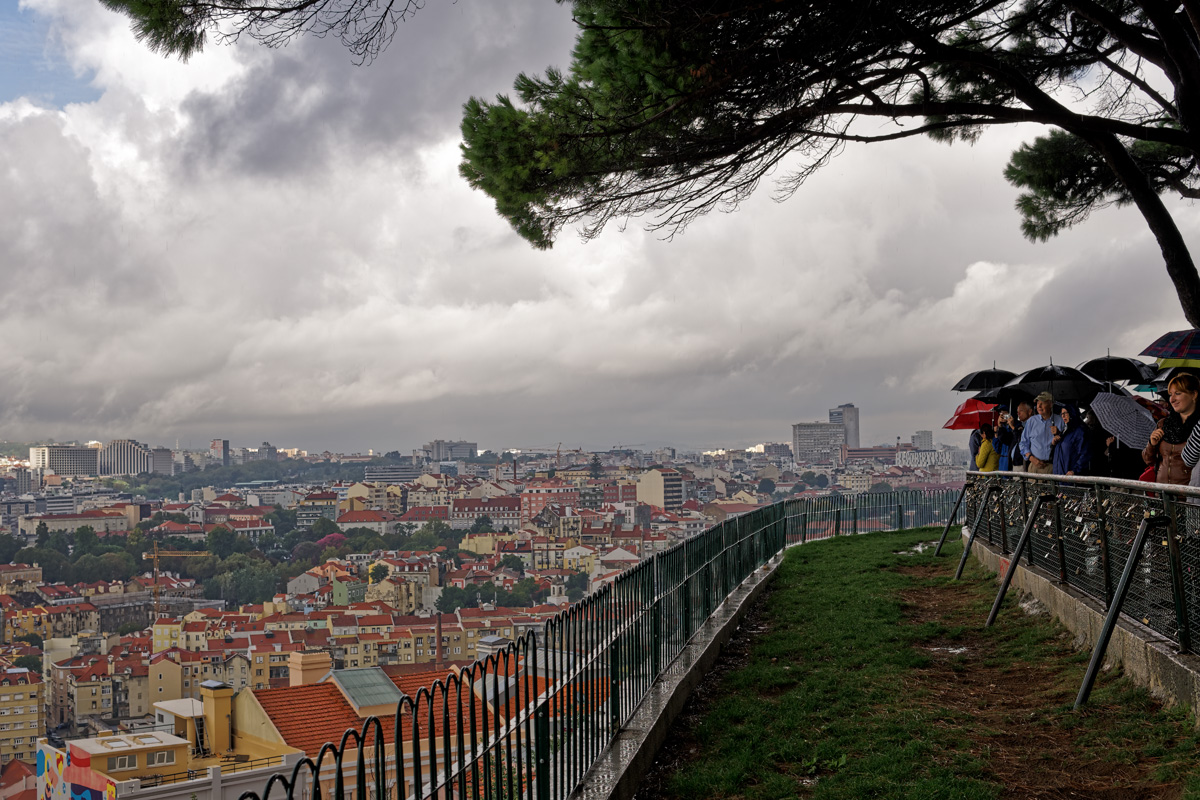
After lunch on the hotel patio (I think nobody left hungry) and a short (very short) rest, off we went with Diago Munoz, a young artist, to see his studio. His lively manner made the visit a lot of fun and a glass of port enhanced our understanding of his unusual painting philosophy. At the end, he gave us one of his Audrey Hepburn paintings, which Gerhard Lipburger later won at our last dinner in Obidos.
On we went by bus to another artist´s studio, very different, and by the time we left the sun had come out.
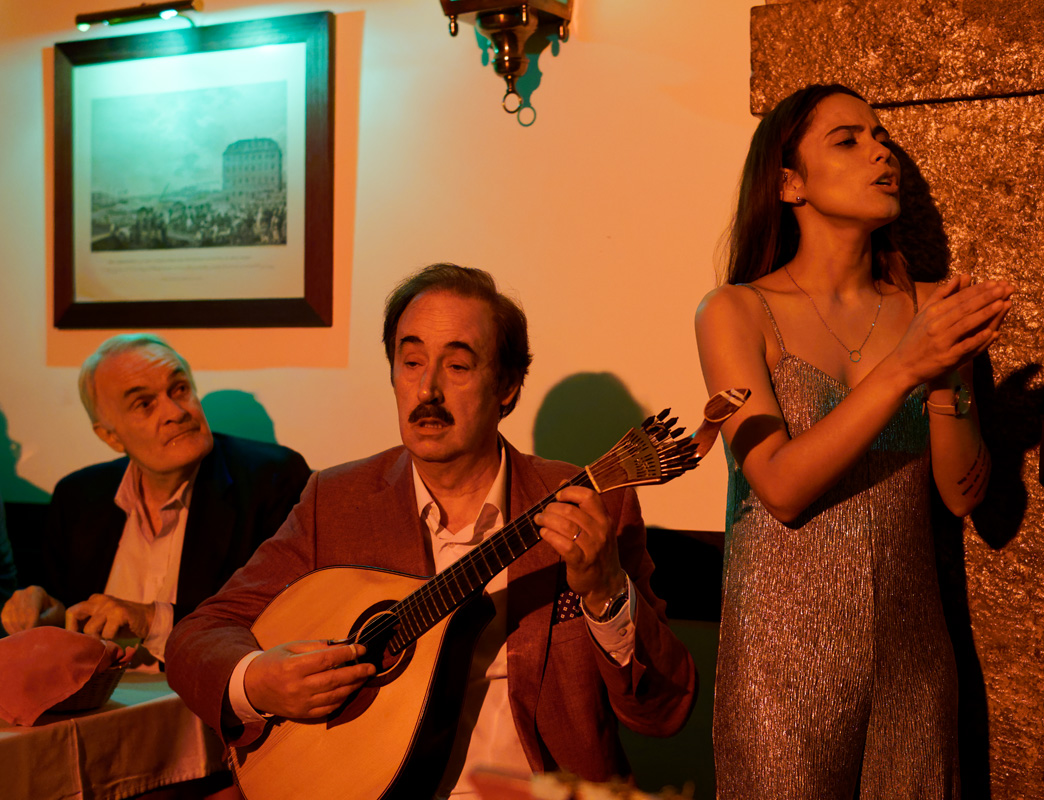 After a short rest and just enough time for a shower and change, off we went to The Clube do Fado. The brave ones among us walked, the others took special vans. We met there with a glass of Vinho Verde in our hands.
After a short rest and just enough time for a shower and change, off we went to The Clube do Fado. The brave ones among us walked, the others took special vans. We met there with a glass of Vinho Verde in our hands.
Fado is special. Perhaps I am not the right person to talk about it, because I don´t particularly like Fado, but the evening was fun and different. We could have stayed till 2 am to hear the music, but we left for the hotel, our U.S. participants still a little jet-lagged.
Again the brave ones walked home. The “clever” ones went by cab and awaited the walkers’ arrival sitting in the bar of the pousada, enjoying a last glass of vintage port. (Thank you, Robert Binney!)
Sunday, 16.10.
A long day awaited us.
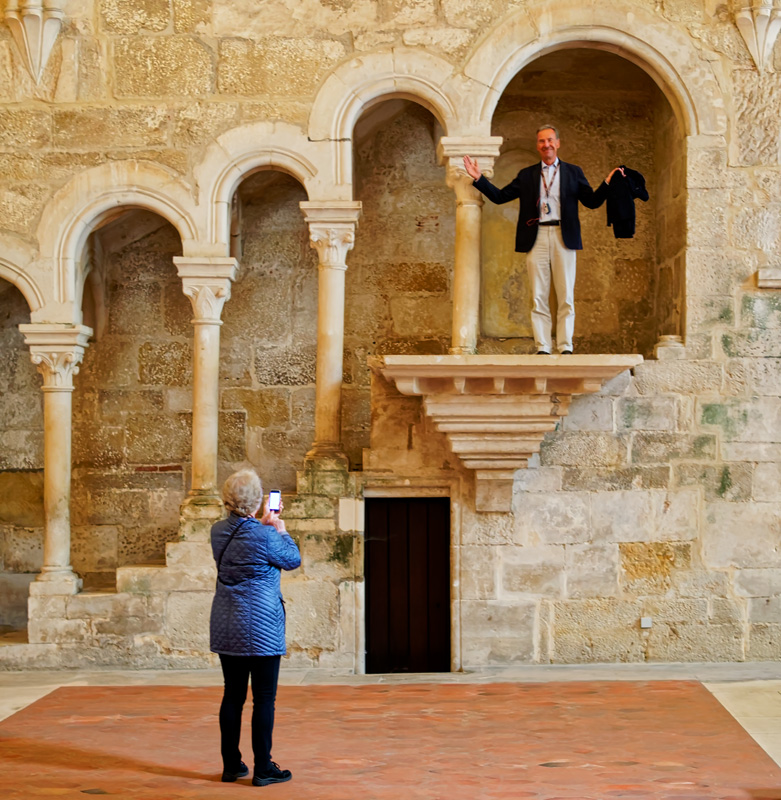
In the morning, two old-fashioned trams waited for us in front of the hotel and drove us out to Belem. We visited the Jeronimo Monastery with its beautiful cloister and overwhelming ornamentation in the Manueline style– representative of Portugal’s rich era of discovery.
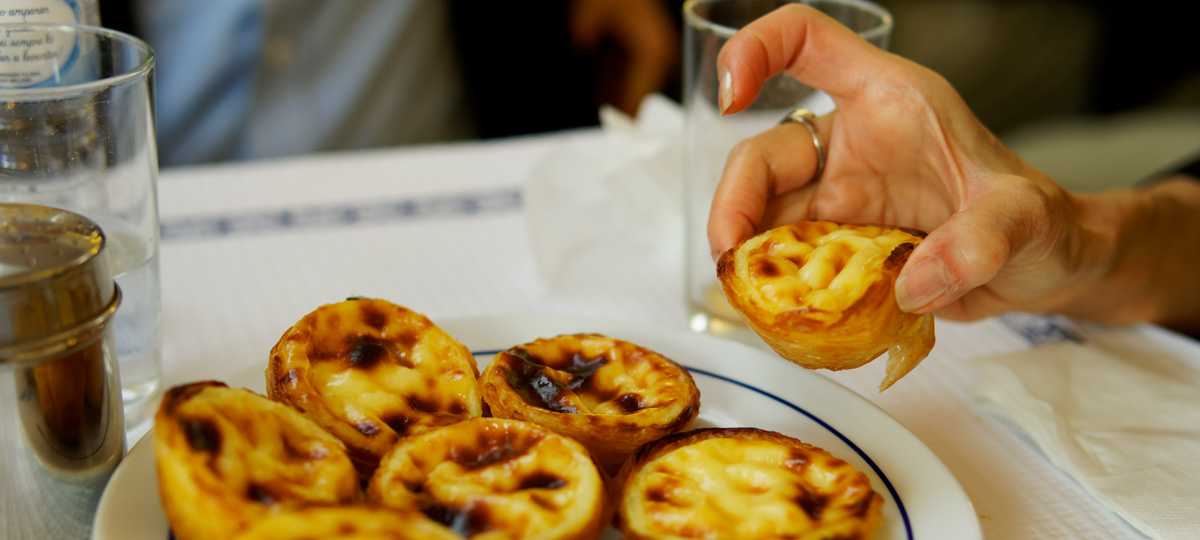
To revive ourselves, we went to the Pasteria de Belem, where the owner Miguel Clarinha showed us the bakery and we tasted the really wonderful Portuguese egg custard tarts called pasteis–the BEST in the world!
After visiting the Torre de Belem (the seafarer monument is unfortunately under restoration), we went on to Sintra, the summer residence of the Portuguese kings. Michelle took us through the Palacio Nacional, he best-preserved medieval royal residence in Portugal. We were all thrilled by the Swan Room and, especially, the Magpie Room and the story behind it. (Magpies are painted on the ceiling and the frieze and hold the emblem por bem (for honor) in their beaks. This relates to the story that King John I was caught in the act of kissing a lady-in-waiting by his queen Philippa of Lancaster. To put a stop to all the gossip, he had the room decorated with as many magpies as there were women at the court.) He must have been a king with a good sense of humor!
Afterwards we spent some time at the Cabo de Rocca, the most western point of the continent. (If your eyesight is very good, you could almost see the Statue of Liberty.) After some difficulties with directions, we arrived at CAA member Axel von Hirschberg´s beautiful Quinta da Palma, where he and his wife gave us a lovely welcome. We also met Dona Isabel and Dom Duarte de Braganza, the pretender to the former Portuguese throne, as well as Manuel de Heredia (Dona Isabel´s brother and good friend of Wolfgang Fenkart-Froeschl), who joined us for drinks and then dinner at the beach restaurant Adraga. The seafood hors d`oeuvres and fish entrée were superb! After a long day, we were very happy to get on our bus, and I think everybody agreed that our bus driver deserved a round of applause as we returned to the hotel, driving through very narrow streets and several times holding up all traffic.
Monday 17.10.
Our early (8 am) departure was almost unanimously and loudly voted down, so we were a little pressed for time the whole day.
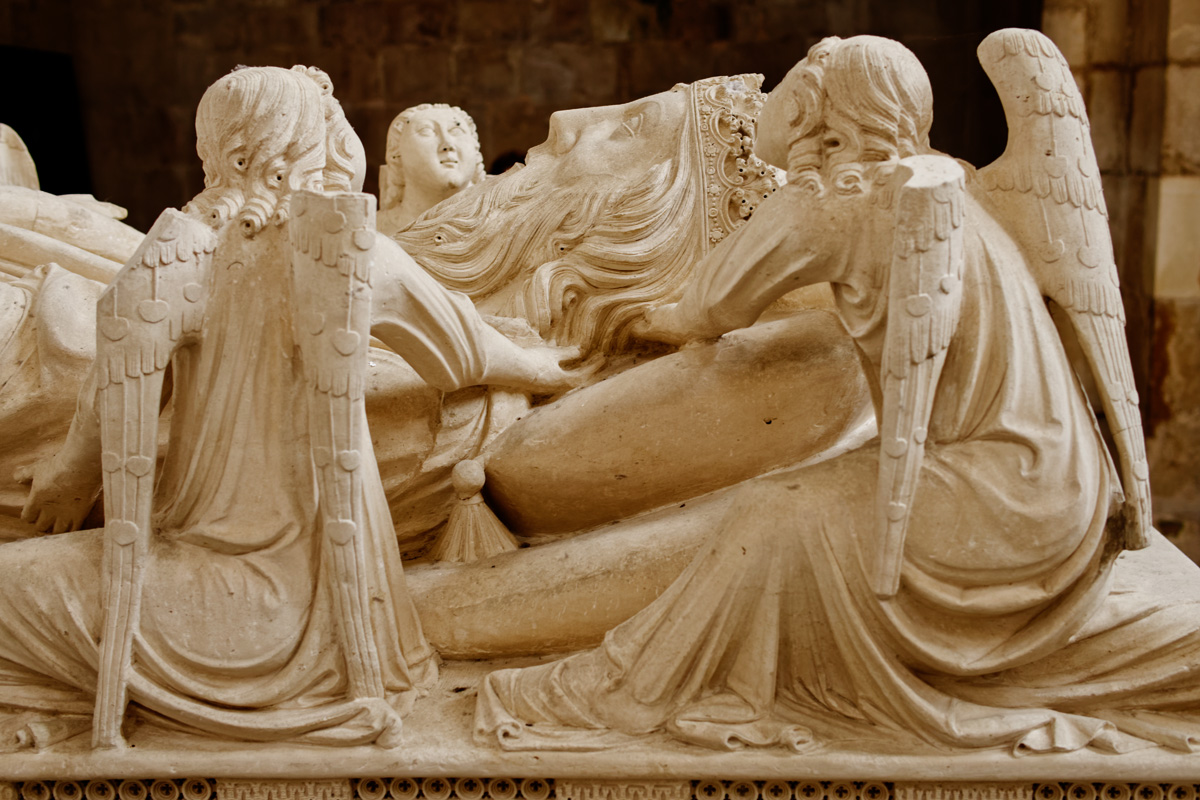 Our first stop was at the beautiful monastery of Alcobaza. We heard the tragic story of Dona Ines de Castro and Dom Pedro I. (Click here for Gerlinde’s account of the star-crossed lovers.) They were buried in two beautifully carved sarcophagi that face each other, so that on the day of the last judgment, when they rise from the dead, the first thing they will see will be each other. (King Pedro I's tomb is at right)
Our first stop was at the beautiful monastery of Alcobaza. We heard the tragic story of Dona Ines de Castro and Dom Pedro I. (Click here for Gerlinde’s account of the star-crossed lovers.) They were buried in two beautifully carved sarcophagi that face each other, so that on the day of the last judgment, when they rise from the dead, the first thing they will see will be each other. (King Pedro I's tomb is at right)
For me, the highlight in this monastery is always the enormous kitchen, where we were told the marvelously self-justifying story that ducks, swans, geese and beavers could be eaten at fasting time because they live more in the water than on land and therefore could be considered fish!
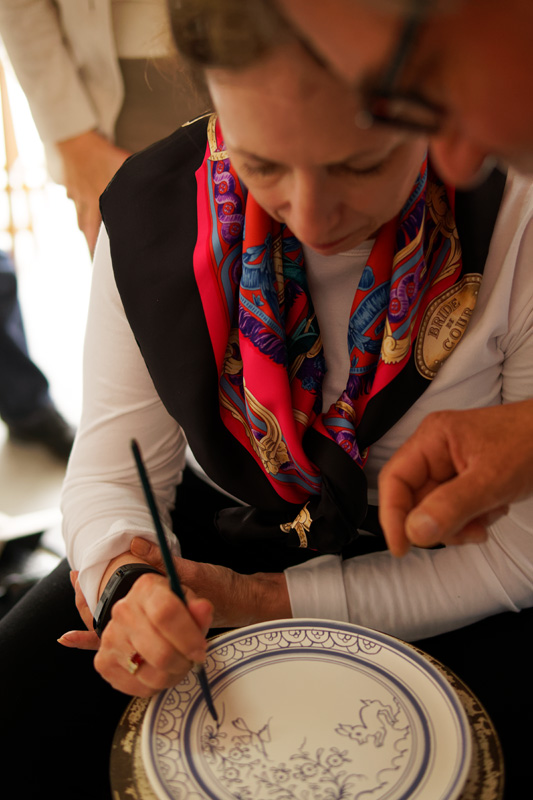 On we went towards Coimbra, the seat of one of the oldest universities of the world. But first we stopped at the atelier of Sr. Domingues, one of the few artists still creating traditional and hand-painted “Coimbra” porcelain using designs from the 16th century. We admired Jeanne Warner (left), who tried her hand at it. (Are you thinking of starting a rival tile studio in Lake Placid, Jeanne?) Unfortunately, we were already late and had to leave. At the end of the visit, each participant received an “azuleijo” (tile) that Sr. Domingues had specially designed , with an ornament reminiscent of the Chase logo on each corner.
On we went towards Coimbra, the seat of one of the oldest universities of the world. But first we stopped at the atelier of Sr. Domingues, one of the few artists still creating traditional and hand-painted “Coimbra” porcelain using designs from the 16th century. We admired Jeanne Warner (left), who tried her hand at it. (Are you thinking of starting a rival tile studio in Lake Placid, Jeanne?) Unfortunately, we were already late and had to leave. At the end of the visit, each participant received an “azuleijo” (tile) that Sr. Domingues had specially designed , with an ornament reminiscent of the Chase logo on each corner.
We lunched in Coimbra in a small restaurant with a Fado singer accompanying our meal. After this (and a heavy stomach), we mounted a lot of stairs to the old university (yet more steps!). There we admired the Sala dos Capelos with portraits of Portuguese monarchs and the wonderful and impressive library. We were told that every night bats come out of two hidden doors and feast on the insects that might hurt the valuable books–true? Apparently even our ancestors were ecology driven.
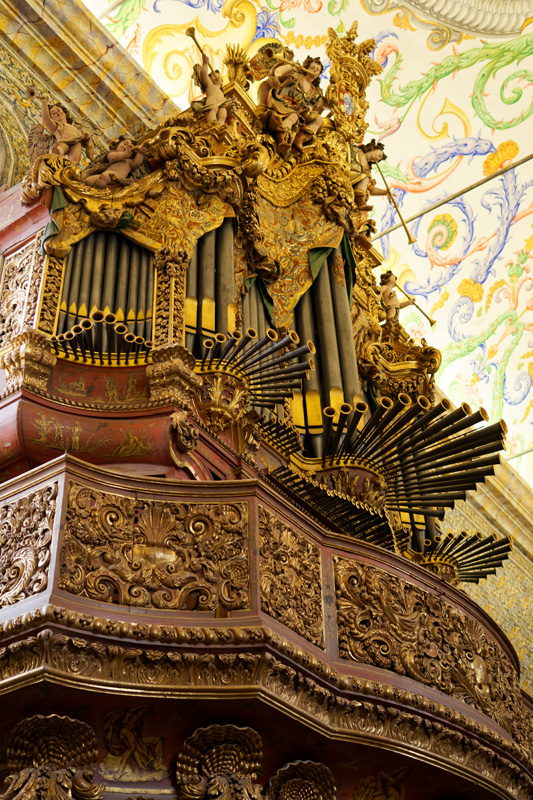
 After a short visit to the university church (organ at right), where only people who attended the university can get married, we went by bus to the Quinta das Lagrimas, our hotel for one night.
After a short visit to the university church (organ at right), where only people who attended the university can get married, we went by bus to the Quinta das Lagrimas, our hotel for one night.
Quinta das Lagrimas (estate of the tears) is the hunting palace where Ines de Castro was murdered. Unfortunately, the rain made it impossible to have our cocktails at the fountain “where you can still see her blood on the stones”.
Dinner was served in the palace’s pretty private dining room and the cook did a marvelous job: the desert was almost a piece of art. After a glass of very good vintage port we went to bed. And nobody heard any mourning or moaning in the allegedly ghost-inhabited hallways!
Tuesday 18.10.
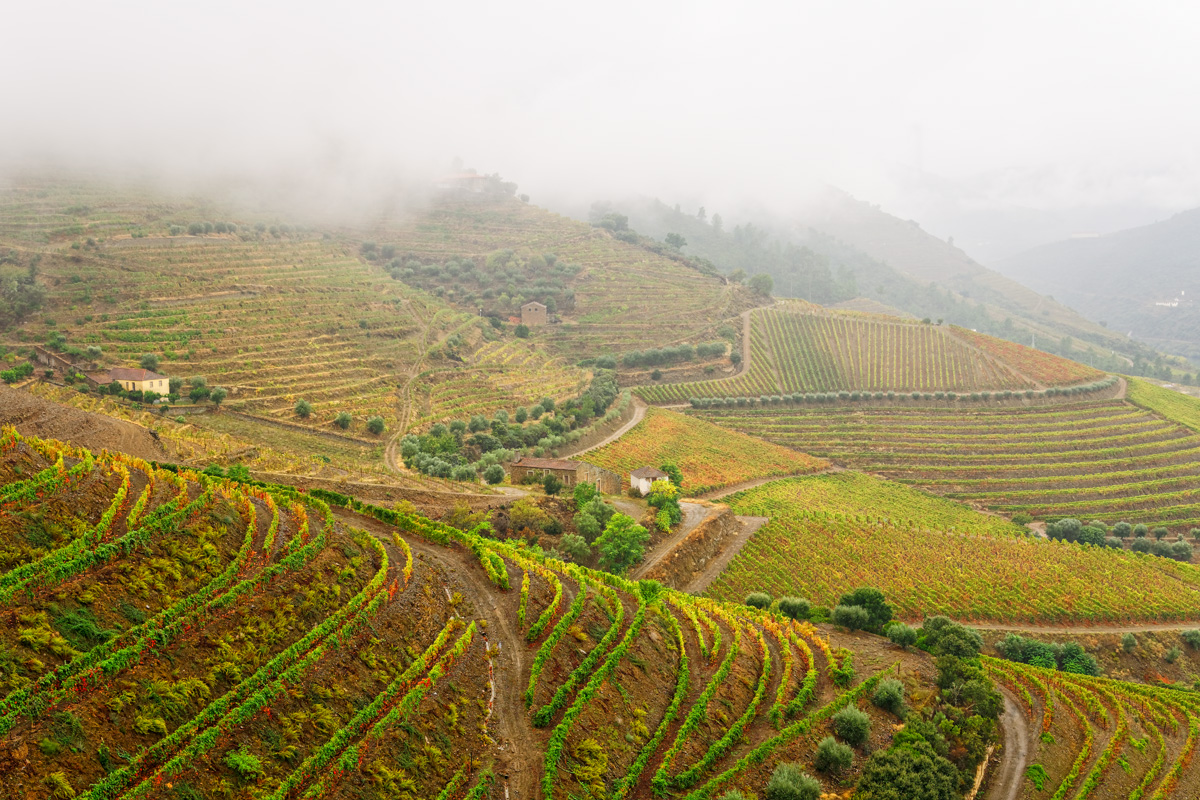 Next day we took a scenic if rain-logged drive to the Douro Valley. At Pinhao, two boats were already waiting for us to take us up the Douro to the Quinta da Gricha, the principal vineyard of Churchill`s Winery (left). It lies embedded in rolling hills full of vines, high above the Douro, and offers spectacular views (even when it is raining).
Next day we took a scenic if rain-logged drive to the Douro Valley. At Pinhao, two boats were already waiting for us to take us up the Douro to the Quinta da Gricha, the principal vineyard of Churchill`s Winery (left). It lies embedded in rolling hills full of vines, high above the Douro, and offers spectacular views (even when it is raining).
While drying out during a special wine- and port tasting, John Graham, part owner and CEO of Churchill’s Port Wineries, explained the differences and procedures of port winemaking. After we had lunch in the giant kitchen (with more wine and port wine!), he took us down to the basement to show us the old stone basins, where the grapes are still being pressed today in the old-fashioned way by men treading on them for long, long hours. Sometimes they are accompanied by rhythmic music, which I guess makes it a little easier.
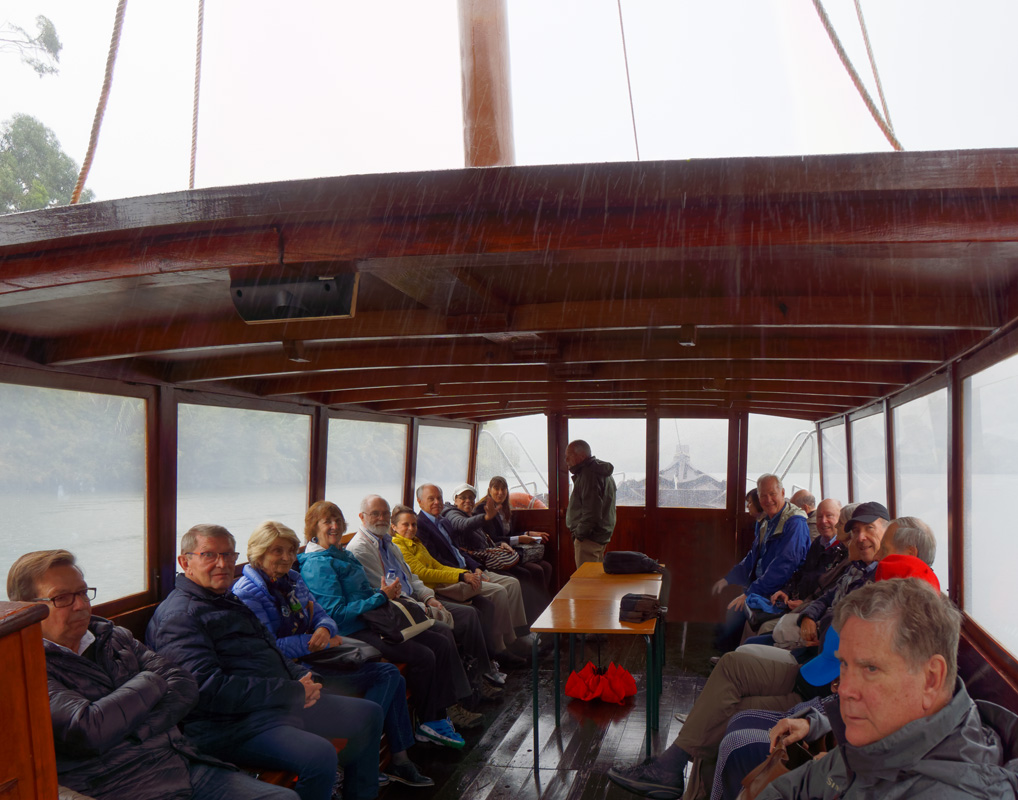 We went back by boat (left) to the bus and on towards Porto, where Jim Adamson and his wife, Vivian, were already waiting for us. Jim, a Chase alumnus who spends part of the year in Portugal, helped Wolfgang in planning the trip. Our hotel in Porto, also a Pousada, was located on the quay with a wonderful view over the river, of the bridges (designed by Gustave Eiffel of Tower fame) and of the other side of the river, Vila Nova de Gaia, where all the port wine cellars are.
We went back by boat (left) to the bus and on towards Porto, where Jim Adamson and his wife, Vivian, were already waiting for us. Jim, a Chase alumnus who spends part of the year in Portugal, helped Wolfgang in planning the trip. Our hotel in Porto, also a Pousada, was located on the quay with a wonderful view over the river, of the bridges (designed by Gustave Eiffel of Tower fame) and of the other side of the river, Vila Nova de Gaia, where all the port wine cellars are.
We had a buffet dinner in a private room of the hotel, so everybody could go to bed or stay up, depending on sleepiness (or wine consumption)
Wednesday, 19.10.
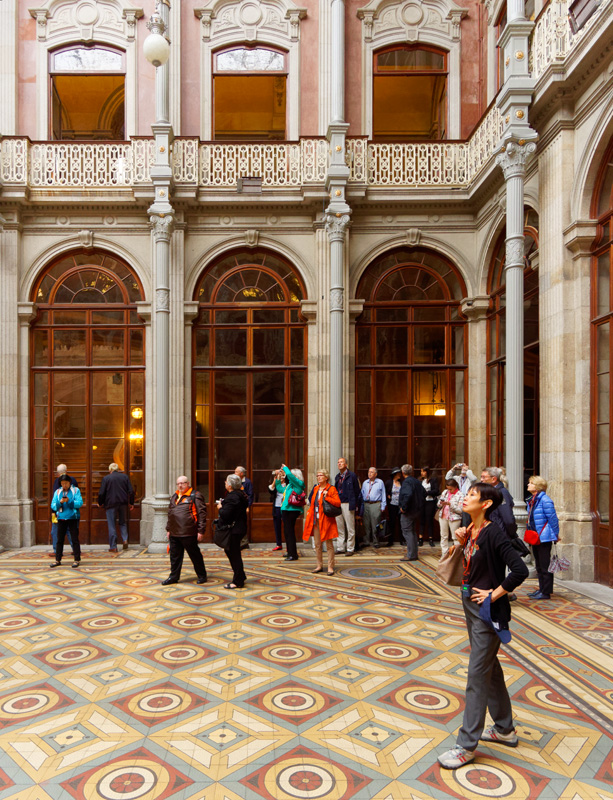 The next morning, Michelle took us on a walking tour, first to São Francisco Church with its golden altar and the unique “Tree of Jesse” in the side altar. Then it was on to the Palaçio de Bolsa (stock exchange, left) and to the Estação de Sao Bento, the main train station with its beautiful blue tiles and the bookshop. Tired from walking, we took the bus up to Graham’s, where Jim had arranged a buffet luncheon for us. The view from the restaurant`s terrace is the best I have seen from Porto and Gaia.
The next morning, Michelle took us on a walking tour, first to São Francisco Church with its golden altar and the unique “Tree of Jesse” in the side altar. Then it was on to the Palaçio de Bolsa (stock exchange, left) and to the Estação de Sao Bento, the main train station with its beautiful blue tiles and the bookshop. Tired from walking, we took the bus up to Graham’s, where Jim had arranged a buffet luncheon for us. The view from the restaurant`s terrace is the best I have seen from Porto and Gaia.
Afternoon was free, so some of our group walked, others took the bus back to the hotel, where a little rest was very welcome after many steps and much port.
The evening began with a short walk to the Factory House, a century old institution of the British wine merchants in Portugal. Our hosts were Peter Symington and his wife, good friends of Vivian and Jim. Peter Symington comes from one of the oldest English families in the port wine business and is part owner of Graham’s Winery. The Factory House is restricted to members of port wine merchants, who must be of English nationality. Today there exist only seven official members, who have to pay their membership dues with vintage port. The Factory House is not open to the public and can only be entered by invitation from one of its members.
We enjoyed a tour through the house (old kitchen, ballroom, etc.), drinks in the drawing room and then an elegant dinner in the beautiful dining room, with exquisite flower arrangements, silver, candles, crystal glasses. After dinner (and welcome and thank you speeches), our host, Peter, announced (I think in a very British way), “We will have 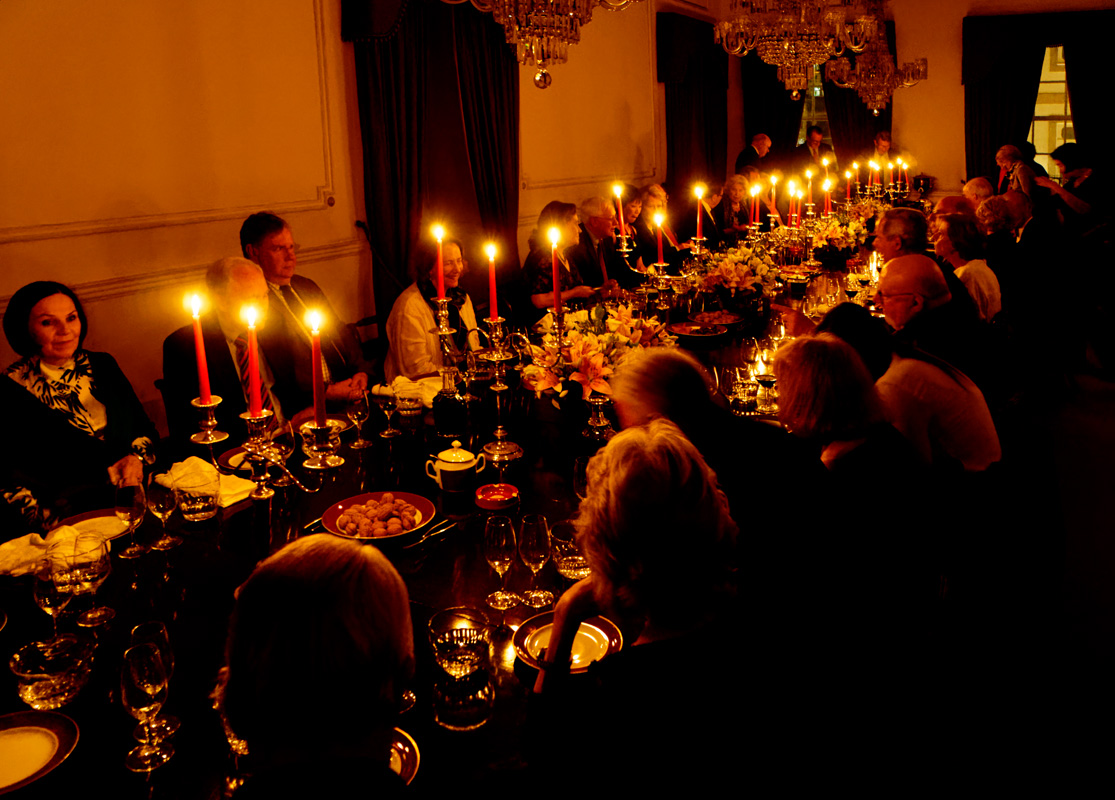 coffee and port in another room.” When the doors opened to this “other room”, there was a moment of silence and then oohs and aahs. It was glorious and pure elegance, with another long table with more flowers, silver, etc., and candlelight reflected on the beautiful wood of the table. For me, it was the highlight of the trip. Coffee, port, a toast to the Queen…the evening could not have been better.
coffee and port in another room.” When the doors opened to this “other room”, there was a moment of silence and then oohs and aahs. It was glorious and pure elegance, with another long table with more flowers, silver, etc., and candlelight reflected on the beautiful wood of the table. For me, it was the highlight of the trip. Coffee, port, a toast to the Queen…the evening could not have been better.
At the hotel, a resilient group stayed for another glass of wine at the bar (thank you, Jeanne), and slowly let the evening fade out.
Thursday, 20.10.
After breakfast and all the luggage stowed in the bus, we started back towards Lisbon. Our first stop was in Tomar, with its early 12th century Templar fortress and a beautifully decorated and unusual octagonal church in a convent.
A short stop: Jean Marc Bara took a (I think THE official) group photo on the steps of the castle.
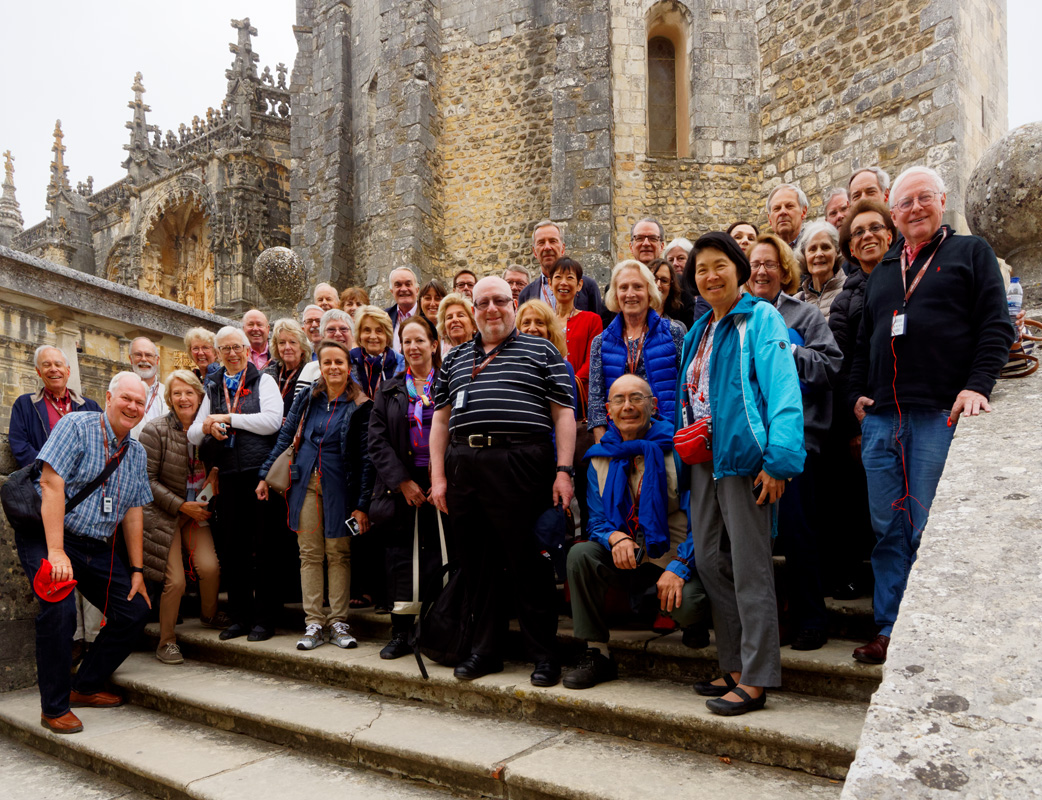
The Manueline window (covered for centuries) was photographed, the cells of the monks looked into, some fruits were bought at the fruit stand outside and off we went.
We enjoyed lunch amidst sunshine, overlooking a pretty little lake, eating cabrito (goat), very typical for Portugal.
Finally, we checked in at the Marriot Beach Hotel. I heard everybody had a beautiful view onto the Atlantic from their rooms. We freshened up and immediately went back to Obidos, so we would still be there by daylight. Obidos is 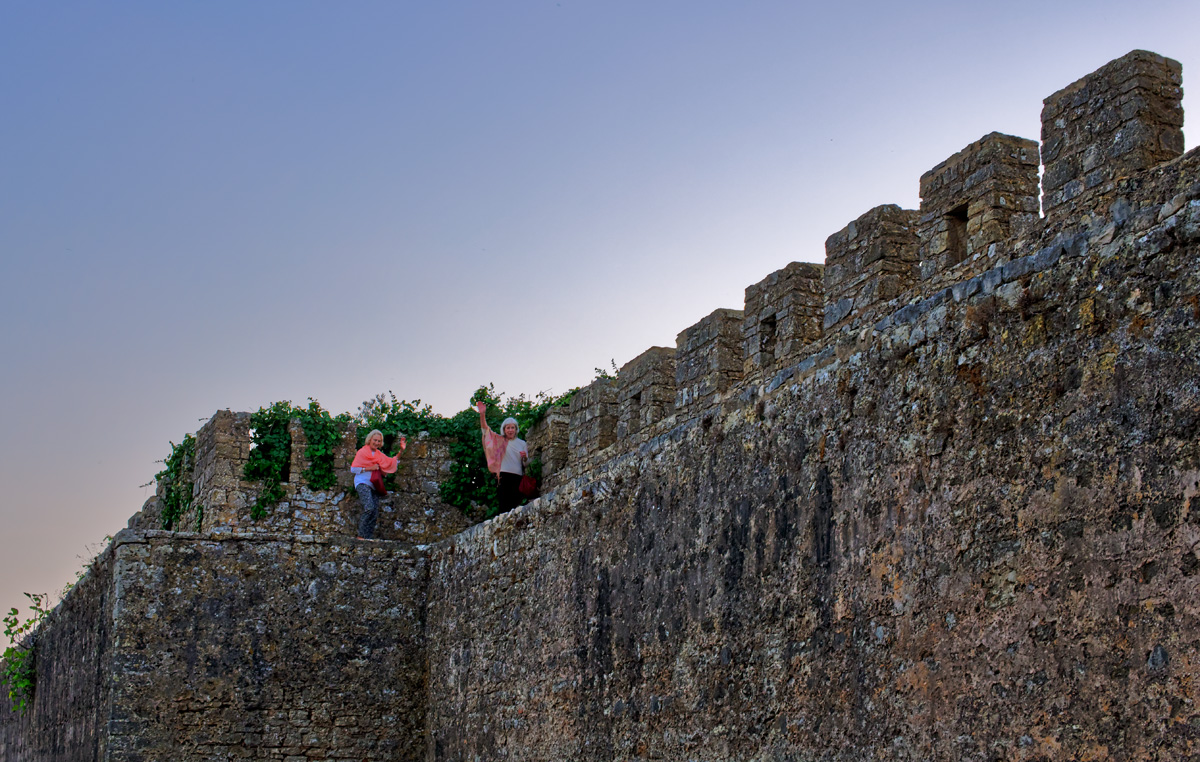 completely “medieval” (though not the shops!), and with its surrounding wall a beautiful sight. Quite a number of our group were brave enough to walk the wall’s parapets (parts are quite scary, no railings!). The others bought postcards or had a try of the ginja (sour cherry liqueur) served in little chocolate cups, very typical for the region (and quite delicious).
completely “medieval” (though not the shops!), and with its surrounding wall a beautiful sight. Quite a number of our group were brave enough to walk the wall’s parapets (parts are quite scary, no railings!). The others bought postcards or had a try of the ginja (sour cherry liqueur) served in little chocolate cups, very typical for the region (and quite delicious).
On our last evening, we all met for cocktails in the old Obidos Castle, today a very beautiful Pousada –just chosen as one of the 500 most attractive hotels in the world. Our good-bye dinner was served in the elegant dining room, and I think everybody already felt “Saudade” (see Fado). Speeches were made, and we sang Happy Birthday to Robert Binney on the eve of his birthday.
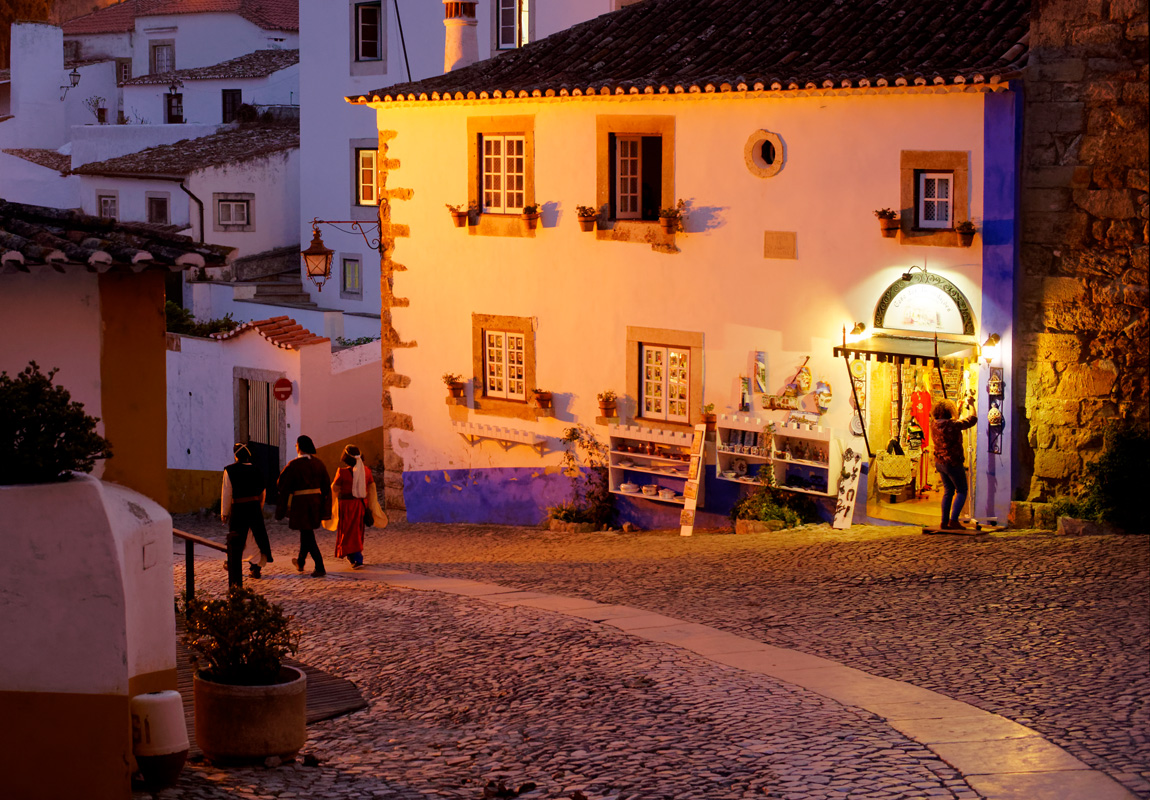 We went back through the sleepy little town to the hotel for our last night. (Some night owls ended again at the bar!) Early the next morning, the bus took us to the airport.
We went back through the sleepy little town to the hotel for our last night. (Some night owls ended again at the bar!) Early the next morning, the bus took us to the airport.
* * *
Wolfgang and I love Portugal, its beautiful landscape, castles, ruins, monasteries and its always friendly people. We hope we could share a little bit of this love with you, so that one day you might come back. There is still so much to see in this small country.
